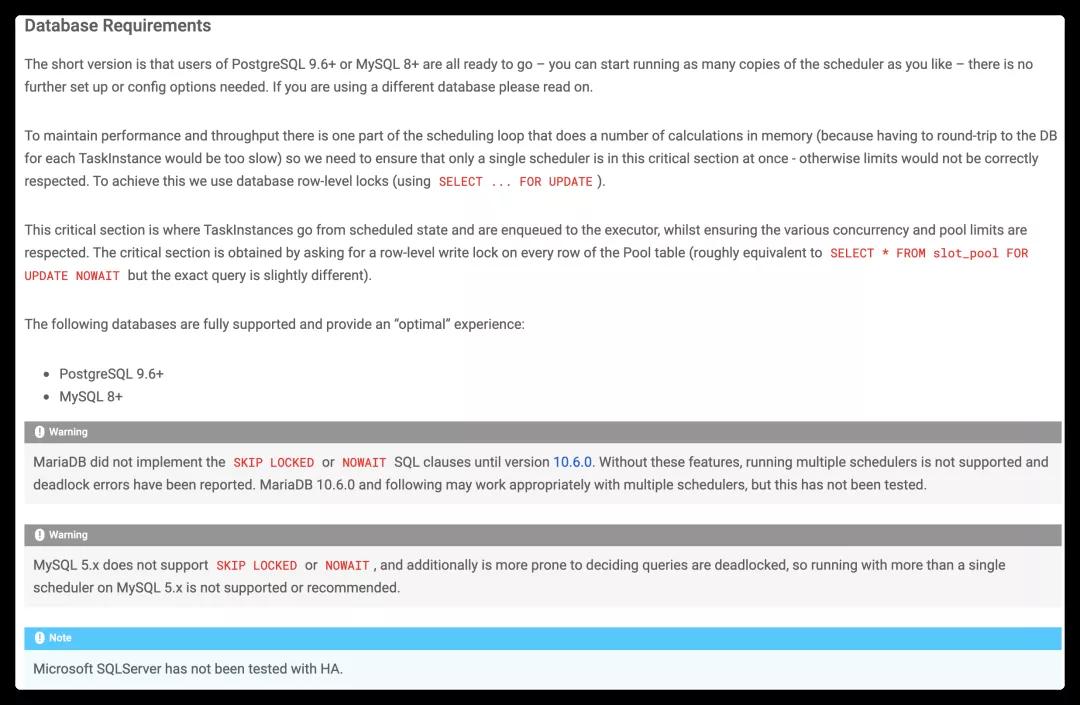上文简单的了解了airflow的概念与使用场景,今天就通过Docker安装一下Airflow,在使用中在深入的了解一下airflow有哪些具体的功能。
1Airflow容器化部署
阿里云的宿主机环境:
- 操作系统: Ubuntu 20.04.3 LTS
- 内核版本: Linux 5.4.0-91-generic
安装docker
安装Docker可参考官方文档[1],纯净系统,就没必要卸载旧版本了,因为是云上平台,为防止配置搞坏环境,你可以先提前进行快照。
- # 更新repo
- sudo apt-get update
- sudo apt-get install \
- ca-certificates \
- curl \
- gnupg \
- lsb-release
- # 添加docker gpg key
- curl -fsSL https://download.docker.com/linux/ubuntu/gpg | sudo gpg --dearmor -o /usr/share/keyrings/docker-archive-keyring.gpg
- # 设置docker stable仓库地址
- echo \
- "deb [arch=$(dpkg --print-architecture) signed-by=/usr/share/keyrings/docker-archive-keyring.gpg] https://download.docker.com/linux/ubuntu \
- $(lsb_release -cs) stable" | sudo tee /etc/apt/sources.list.d/docker.list > /dev/null
- # 查看可安装的docker-ce版本
- root@bigdata1:~# apt-cache madison docker-ce
- docker-ce | 5:20.10.12~3-0~ubuntu-focal | https://download.docker.com/linux/ubuntu focal/stable amd64 Packages
- docker-ce | 5:20.10.11~3-0~ubuntu-focal | https://download.docker.com/linux/ubuntu focal/stable amd64 Packages
- docker-ce | 5:20.10.10~3-0~ubuntu-focal | https://download.docker.com/linux/ubuntu focal/stable amd64 Packages
- docker-ce | 5:20.10.9~3-0~ubuntu-focal | https://download.docker.com/linux/ubuntu focal/stable amd64 Packages
- # 安装命令格式
- #sudo apt-get install docker-ce=<VERSION_STRING> docker-ce-cli=<VERSION_STRING> containerd.io
- # 安装指定版本
- sudo apt-get install docker-ce=5:20.10.12~3-0~ubuntu-focal docker-ce-cli=5:20.10.12~3-0~ubuntu-focal containerd.io
优化Docker配置
- {
- "data-root": "/var/lib/docker",
- "exec-opts": [
- "native.cgroupdriver=systemd"
- ],
- "registry-mirrors": [
- "https://****.mirror.aliyuncs.com" #此处配置一些加速的地址,比如阿里云的等等...
- ],
- "storage-driver": "overlay2",
- "storage-opts": [
- "overlay2.override_kernel_check=true"
- ],
- "log-driver": "json-file",
- "log-opts": {
- "max-size": "100m",
- "max-file": "3"
- }
- }
配置开机自己
- systemctl daemon-reload
- systemctl enable --now docker.service
容器化安装Airflow
数据库选型
根据官网的说明,数据库建议使用MySQL8+和postgresql 9.6+,在官方的docker-compose脚本[2]中使用是PostgreSQL,因此我们需要调整一下docker-compose.yml的内容
- ---
- version: '3'
- x-airflow-common:
- &airflow-common
- # In order to add custom dependencies or upgrade provider packages you can use your extended image.
- # Comment the image line, place your Dockerfile in the directory where you placed the docker-compose.yaml
- # and uncomment the "build" line below, Then run `docker-compose build` to build the images.
- image: ${AIRFLOW_IMAGE_NAME:-apache/airflow:2.2.3}
- # build: .
- environment:
- &airflow-common-env
- AIRFLOW__CORE__EXECUTOR: CeleryExecutor
- AIRFLOW__CORE__SQL_ALCHEMY_CONN: mysql+mysqldb://airflow:aaaa@mysql/airflow # 此处替换为mysql连接方式
- AIRFLOW__CELERY__RESULT_BACKEND: db+mysql://airflow:aaaa@mysql/airflow # 此处替换为mysql连接方式
- AIRFLOW__CELERY__BROKER_URL: redis://:xxxx@redis:6379/0 # 为保证安全,我们对redis开启了认证,因此将此处xxxx替换为redis密码
- AIRFLOW__CORE__FERNET_KEY: ''
- AIRFLOW__CORE__DAGS_ARE_PAUSED_AT_CREATION: 'true'
- AIRFLOW__CORE__LOAD_EXAMPLES: 'true'
- AIRFLOW__API__AUTH_BACKEND: 'airflow.api.auth.backend.basic_auth'
- _PIP_ADDITIONAL_REQUIREMENTS: ${_PIP_ADDITIONAL_REQUIREMENTS:-}
- volumes:
- - ./dags:/opt/airflow/dags
- - ./logs:/opt/airflow/logs
- - ./plugins:/opt/airflow/plugins
- user: "${AIRFLOW_UID:-50000}:0"
- depends_on:
- &airflow-common-depends-on
- redis:
- condition: service_healthy
- mysql: # 此处修改为mysql service名称
- condition: service_healthy
- services:
- mysql:
- image: mysql:8.0.27 # 修改为mysql最新版镜像
- environment:
- MYSQL_ROOT_PASSWORD: bbbb # MySQL root账号密码
- MYSQL_USER: airflow
- MYSQL_PASSWORD: aaaa # airflow用户的密码
- MYSQL_DATABASE: airflow
- command:
- --default-authentication-plugin=mysql_native_password # 指定默认的认证插件
- --collation-server=utf8mb4_general_ci # 依据官方指定字符集
- --character-set-server=utf8mb4 # 依据官方指定字符编码
- volumes:
- - /apps/airflow/mysqldata8:/var/lib/mysql # 持久化MySQL数据
- - /apps/airflow/my.cnf:/etc/my.cnf # 持久化MySQL配置文件
- healthcheck:
- test: mysql --user=$$MYSQL_USER --password=$$MYSQL_PASSWORD -e 'SHOW DATABASES;' # healthcheck command
- interval: 5s
- retries: 5
- restart: always
- redis:
- image: redis:6.2
- expose:
- - 6379
- command: redis-server --requirepass xxxx # redis-server开启密码认证
- healthcheck:
- test: ["CMD", "redis-cli","-a","xxxx","ping"] # redis使用密码进行healthcheck
- interval: 5s
- timeout: 30s
- retries: 50
- restart: always
- airflow-webserver:
- <<: *airflow-common
- command: webserver
- ports:
- - 8080:8080
- healthcheck:
- test: ["CMD", "curl", "--fail", "http://localhost:8080/health"]
- interval: 10s
- timeout: 10s
- retries: 5
- restart: always
- depends_on:
- <<: *airflow-common-depends-on
- airflow-init:
- condition: service_completed_successfully
- airflow-scheduler:
- <<: *airflow-common
- command: scheduler
- healthcheck:
- test: ["CMD-SHELL", 'airflow jobs check --job-type SchedulerJob --hostname "$${HOSTNAME}"']
- interval: 10s
- timeout: 10s
- retries: 5
- restart: always
- depends_on:
- <<: *airflow-common-depends-on
- airflow-init:
- condition: service_completed_successfully
- airflow-worker:
- <<: *airflow-common
- command: celery worker
- healthcheck:
- test:
- - "CMD-SHELL"
- - 'celery --app airflow.executors.celery_executor.app inspect ping -d "celery@$${HOSTNAME}"'
- interval: 10s
- timeout: 10s
- retries: 5
- environment:
- <<: *airflow-common-env
- # Required to handle warm shutdown of the celery workers properly
- # See https://airflow.apache.org/docs/docker-stack/entrypoint.html#signal-propagation
- DUMB_INIT_SETSID: "0"
- restart: always
- depends_on:
- <<: *airflow-common-depends-on
- airflow-init:
- condition: service_completed_successfully
- airflow-triggerer:
- <<: *airflow-common
- command: triggerer
- healthcheck:
- test: ["CMD-SHELL", 'airflow jobs check --job-type TriggererJob --hostname "$${HOSTNAME}"']
- interval: 10s
- timeout: 10s
- retries: 5
- restart: always
- depends_on:
- <<: *airflow-common-depends-on
- airflow-init:
- condition: service_completed_successfully
- airflow-init:
- <<: *airflow-common
- entrypoint: /bin/bash
- # yamllint disable rule:line-length
- command:
- - -c
- - |
- function ver() {
- printf "%04d%04d%04d%04d" $${1//./ }
- }
- airflow_version=$$(gosu airflow airflow version)
- airflow_version_comparable=$$(ver $${airflow_version})
- min_airflow_version=2.2.0
- min_airflow_version_comparable=$$(ver $${min_airflow_version})
- if (( airflow_version_comparable < min_airflow_version_comparable )); then
- echo
- echo -e "\033[1;31mERROR!!!: Too old Airflow version $${airflow_version}!\e[0m"
- echo "The minimum Airflow version supported: $${min_airflow_version}. Only use this or higher!"
- echo
- exit 1
- fi
- if [[ -z "${AIRFLOW_UID}" ]]; then
- echo
- echo -e "\033[1;33mWARNING!!!: AIRFLOW_UID not set!\e[0m"
- echo "If you are on Linux, you SHOULD follow the instructions below to set "
- echo "AIRFLOW_UID environment variable, otherwise files will be owned by root."
- echo "For other operating systems you can get rid of the warning with manually created .env file:"
- echo " See: https://airflow.apache.org/docs/apache-airflow/stable/start/docker.html#setting-the-right-airflow-user"
- echo
- fi
- one_meg=1048576
- mem_available=$$(($$(getconf _PHYS_PAGES) * $$(getconf PAGE_SIZE) / one_meg))
- cpus_available=$$(grep -cE 'cpu[0-9]+' /proc/stat)
- disk_available=$$(df / | tail -1 | awk '{print $$4}')
- warning_resources="false"
- if (( mem_available < 4000 )) ; then
- echo
- echo -e "\033[1;33mWARNING!!!: Not enough memory available for Docker.\e[0m"
- echo "At least 4GB of memory required. You have $$(numfmt --to iec $$((mem_available * one_meg)))"
- echo
- warning_resources="true"
- fi
- if (( cpus_available < 2 )); then
- echo
- echo -e "\033[1;33mWARNING!!!: Not enough CPUS available for Docker.\e[0m"
- echo "At least 2 CPUs recommended. You have $${cpus_available}"
- echo
- warning_resources="true"
- fi
- if (( disk_available < one_meg * 10 )); then
- echo
- echo -e "\033[1;33mWARNING!!!: Not enough Disk space available for Docker.\e[0m"
- echo "At least 10 GBs recommended. You have $$(numfmt --to iec $$((disk_available * 1024 )))"
- echo
- warning_resources="true"
- fi
- if [[ $${warning_resources} == "true" ]]; then
- echo
- echo -e "\033[1;33mWARNING!!!: You have not enough resources to run Airflow (see above)!\e[0m"
- echo "Please follow the instructions to increase amount of resources available:"
- echo " https://airflow.apache.org/docs/apache-airflow/stable/start/docker.html#before-you-begin"
- echo
- fi
- mkdir -p /sources/logs /sources/dags /sources/plugins
- chown -R "${AIRFLOW_UID}:0" /sources/{logs,dags,plugins}
- exec /entrypoint airflow version
- # yamllint enable rule:line-length
- environment:
- <<: *airflow-common-env
- _AIRFLOW_DB_UPGRADE: 'true'
- _AIRFLOW_WWW_USER_CREATE: 'true'
- _AIRFLOW_WWW_USER_USERNAME: ${_AIRFLOW_WWW_USER_USERNAME:-airflow}
- _AIRFLOW_WWW_USER_PASSWORD: ${_AIRFLOW_WWW_USER_PASSWORD:-airflow}
- user: "0:0"
- volumes:
- - .:/sources
- airflow-cli:
- <<: *airflow-common
- profiles:
- - debug
- environment:
- <<: *airflow-common-env
- CONNECTION_CHECK_MAX_COUNT: "0"
- # Workaround for entrypoint issue. See: https://github.com/apache/airflow/issues/16252
- command:
- - bash
- - -c
- - airflow
- flower:
- <<: *airflow-common
- command: celery flower
- ports:
- - 5555:5555
- healthcheck:
- test: ["CMD", "curl", "--fail", "http://localhost:5555/"]
- interval: 10s
- timeout: 10s
- retries: 5
- restart: always
- depends_on:
- <<: *airflow-common-depends-on
- airflow-init:
- condition: service_completed_successfully
在官方docker-compose.yaml基础上只修改了x-airflow-common,MySQL,Redis相关配置,接下来就应该启动容器了,在启动之前,需要创建几个持久化目录:
- mkdir -p ./dags ./logs ./plugins
- echo -e "AIRFLOW_UID=$(id -u)" > .env # 注意,此处一定要保证AIRFLOW_UID是普通用户的UID,且保证此用户有创建这些持久化目录的权限
如果不是普通用户,在运行容器的时候,会报错,找不到airflow模块
- docker-compose up airflow-init #初始化数据库,以及创建表
- docker-compose up -d #创建airflow容器
当出现容器的状态为unhealthy的时候,要通过docker inspect $container_name查看报错的原因,至此airflow的安装就已经完成了。
参考资料
[1]Install Docker Engine on Ubuntu: https://docs.docker.com/engine/install/ubuntu/
[2]官方docker-compose.yaml: https://airflow.apache.org/docs/apache-airflow/2.2.3/docker-compose.yaml









































